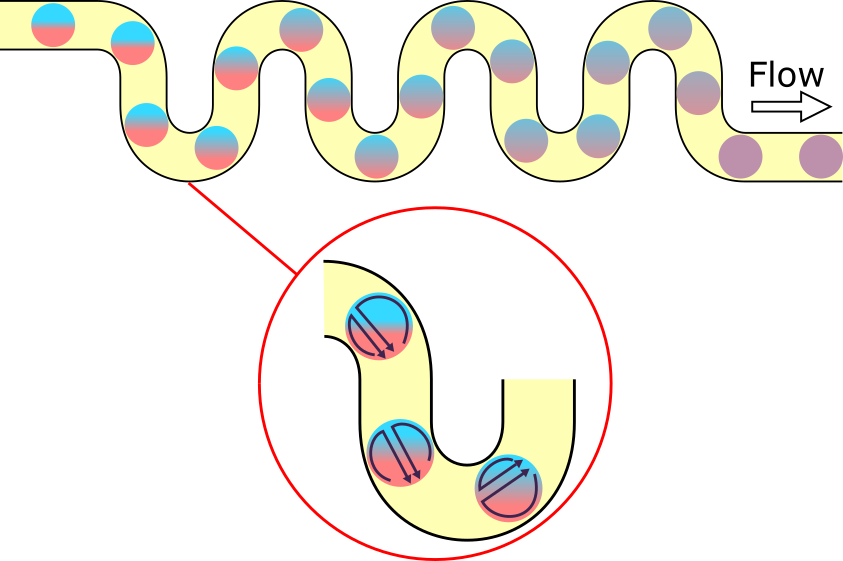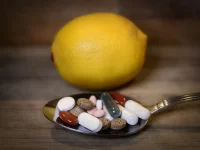From the air you breathe to the water you drink, almost all substances in the natural world are mixtures of numerous components. Air is 78 percent nitrogen, 21 percent oxygen, and the remaining one percent is a variety of other substances, including argon and carbon dioxide. Intermolecular interactions determine the formation of mixtures in the natural environment, but humans have been creating their own mixtures since prehistoric times. Mixing is used in everything from construction to food preparation, and most chemical processes require precise mixing to ensure mixture uniformity. Generally, this is done in very large mixers; however, recent advances have allowed mixing to be conducted at a much smaller scale of microliters instead of thousands of liters.
When working with small volumes of fluid, significant forces can be generated via induced dipole activity from an electric field.
Microfluidic mixing is an up-and-coming technology which utilizes either active or passive mixing on a small scale to uniformly mix small volumes of fluids. This can be useful specifically for biological mixtures where reagents can cost thousands of dollars per milliliter. By miniaturizing mixing, complex biological analysis can be conducted on smaller scales, allowing for single-cell analysis. Quantitative polymerase chain reaction utilizes these microfluidic mixing technologies in order to analyze the protein production on a cellular level. For example, cells can be separated prior to DNA measurement, allowing the protein production of each individual cell to be determined. Additionally, enzymes which normally are used to detect specific proteins could be done in flow settings, allowing for the collection of real-time data. Outside of biochemistry, similar technologies could be used to control reactions which produce large amounts of heat. Finally, this method could be used in environmental testing to bring assays from the lab bench to the field. Technologies like these allow much more precise data to be collected, but require highly precise mixing of reagents.
There are two main types of microfluidic mixing. The first is active mixing, which uses motion or electricity in order to mix substances. When working with small volumes of fluid, significant forces can be generated via induced dipole activity from an electric field. By pulsing the electric field, the force direction can be quickly changed, inducing mixing within the fluid. This technology was demonstrated on a device which was only five millimeters long with a width of less than one millimeter. Further, temperature gradients can be applied in the same way to induce convection currents within the fluids. The final type of force that can be applied in this manner would be an electromagnetic force. By rapidly changing the electromagnetic field, fluids containing charged ions will be exposed to changing forces and will be rapidly intermixed.
Any flowing fluid will be subjected to friction from its contact with the walls of the pipes or tubing it is flowing through.
The other type of microfluidic mixing is passive mixing. Passive mixing utilizes geometry in order to mix fluids. Any flowing fluid will be subjected to friction from its contact with the walls of the pipes or tubing it is flowing through. This frictional force can be used to manipulate the flow direction to promote intermixing between fluids. The simplest form of this mixing is lamination. Lamination brings the fluids together through contact and interactions with the walls, driving the mixing to completion. Because of the small scale, this can be especially effective when low volumes are being mixed. Another type of passive mixing utilizes multiple flow channels to promote mixing. The fluid is split into multiple channels and the intersections between these channels become mixing regions where the different fluids can interact. This similar mixing architecture can be introduced in three dimensions to further improve mixing. Common structures include a serpentine pattern which alternates 90 degree turns in the vertical and horizontal directions. These changes in how fluid contacts the surface impacts the mixing, as surface contact increases frictional forces, slowing down fluid motion and allowing intermixing.
Overall, both active and passive mixing allow for effective mixing of small volumes of fluids. This is important as it allows for mixing and manipulation of small volumes of fluids. While this has generally been applied for biological processes, its applications in medicine, food production, chemistry, and other fields are endless. Maybe one day you can even use microfluidic mixing to mix your iced tea on a hot summer day.
Source: 1
Image Source: Wikimedia Commons




